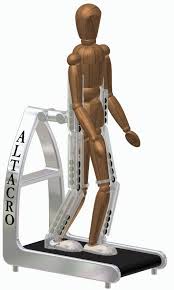Assessment of Human-Robot Interaction

Recently, robotic devices have emerged as promising tools to facilitate rehabilitation. Robot-assisted training provides the means for objective assessment of the therapy process, long training sessions, high accuracy of desired gait patterns and a reduced workload for physical therapists. Yet, some reviews point out that there is little to no clear advantage of robot-assisted gait training over manually assisted gait training as far as rehabilitation outcome is concerned. An apparent reason could be that until now most commercially available assistive devices move the patient along a predefined, fixed trajectory. Determinants of gait training should not only involve repeatability, but also task-specificity, optimal physical and mental engagement, variability, intensity and self-initiative. As such, there is a need to monitor the human response during robot-assisted therapies in order to optimize the therapy outcome. Different hard- and software settings of rehabilitation exoskeletons could after all result in different levels of adaptation, adaptation rate and motor learning. The focus is too often put on the mechanical development and conclusions on its effectiveness are mostly drawn from tests on one or two subjects. Until today, it is not entirely clear how humans interact with robotic devices during walking and how we can, based on that interaction, maximize the effectiveness of exoskeletons during gait rehabilitation.
In a first interdisciplinary project, ALTACRO – Automated Locomotor Training using an Actuated Compliant Robotic Orthosis, MFYS started an intense collaboration with the department of Robotics and Multibody Mechanics (R&MM) of the Vrije Universiteit Brussel in order to develop a gait rehabilitation exoskeleton for subjects with a spinal cord injury. In this project the human-robot interaction with different rehabilitation devices was studied with the emphasis put on the response of the human brain, measured through electroencephalography (EEG) to robot-assisted therapy. Results can be found on: http://altacro.vub.ac.be/.
In a second project, awarded by the European Commission (FP7-ICT-2011-7), CYBERLEGs - The CYBERnetic Lower-Limb Cognitive Ortho-prosthesis, we further look into the human-robot interaction between a cognitive ortho-prosthesis and subjects with a transfemoral amputation. We will use this information to close the loop in the human-robot interaction to ensure that the physical and mental engagement of the patient is optimal. Preliminary results of this project can be found on: http://www.cyberlegs.eu/.
Recently, the collaboration between MFYS and R&MM has also been rewarded by our university with a Strategic Research Program (SRP), ‘Exercise and the Brain in Health & Disease: the Added Value of Human-Centered Robotics’.
Author: Kristel Knaepen
« Back to overview